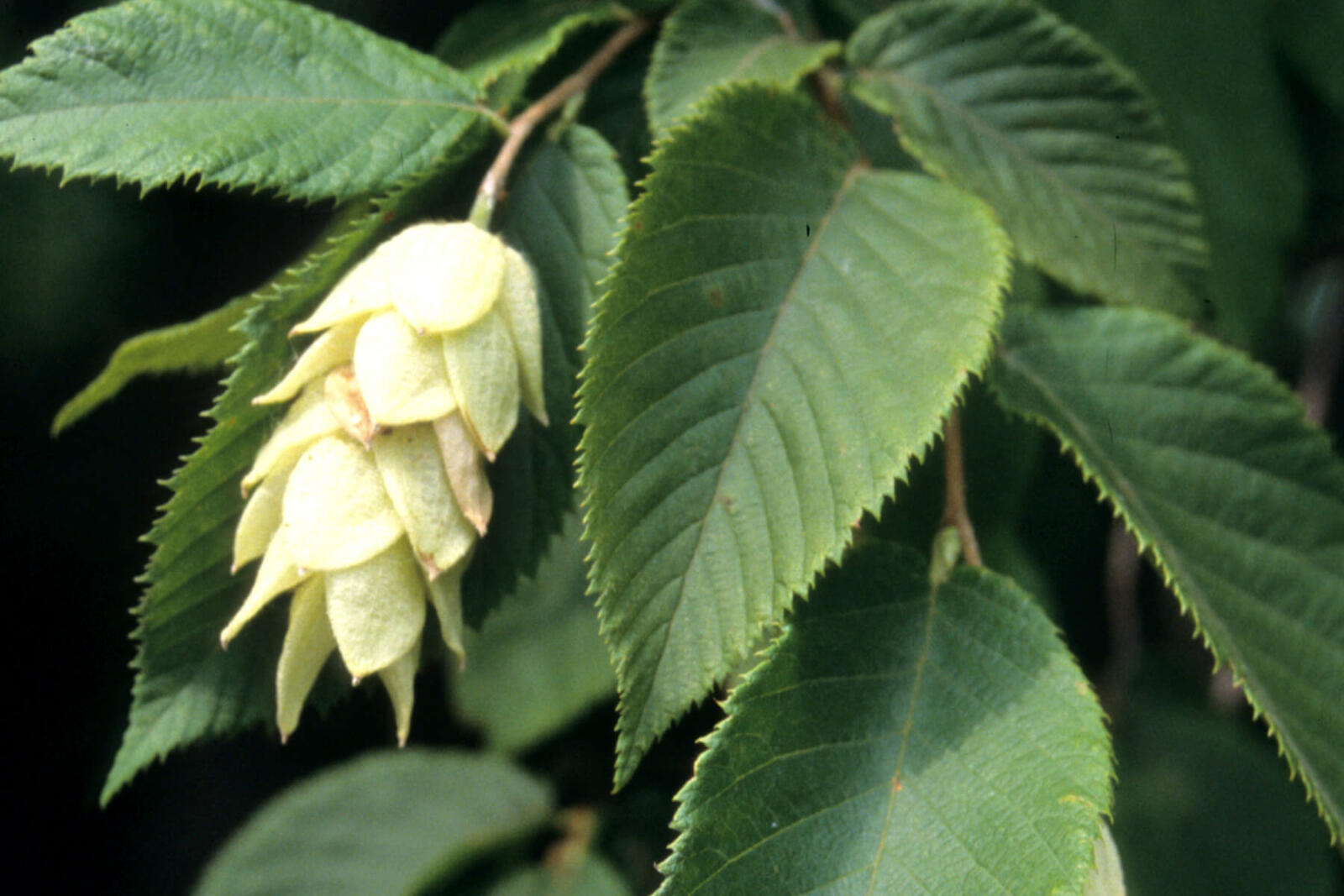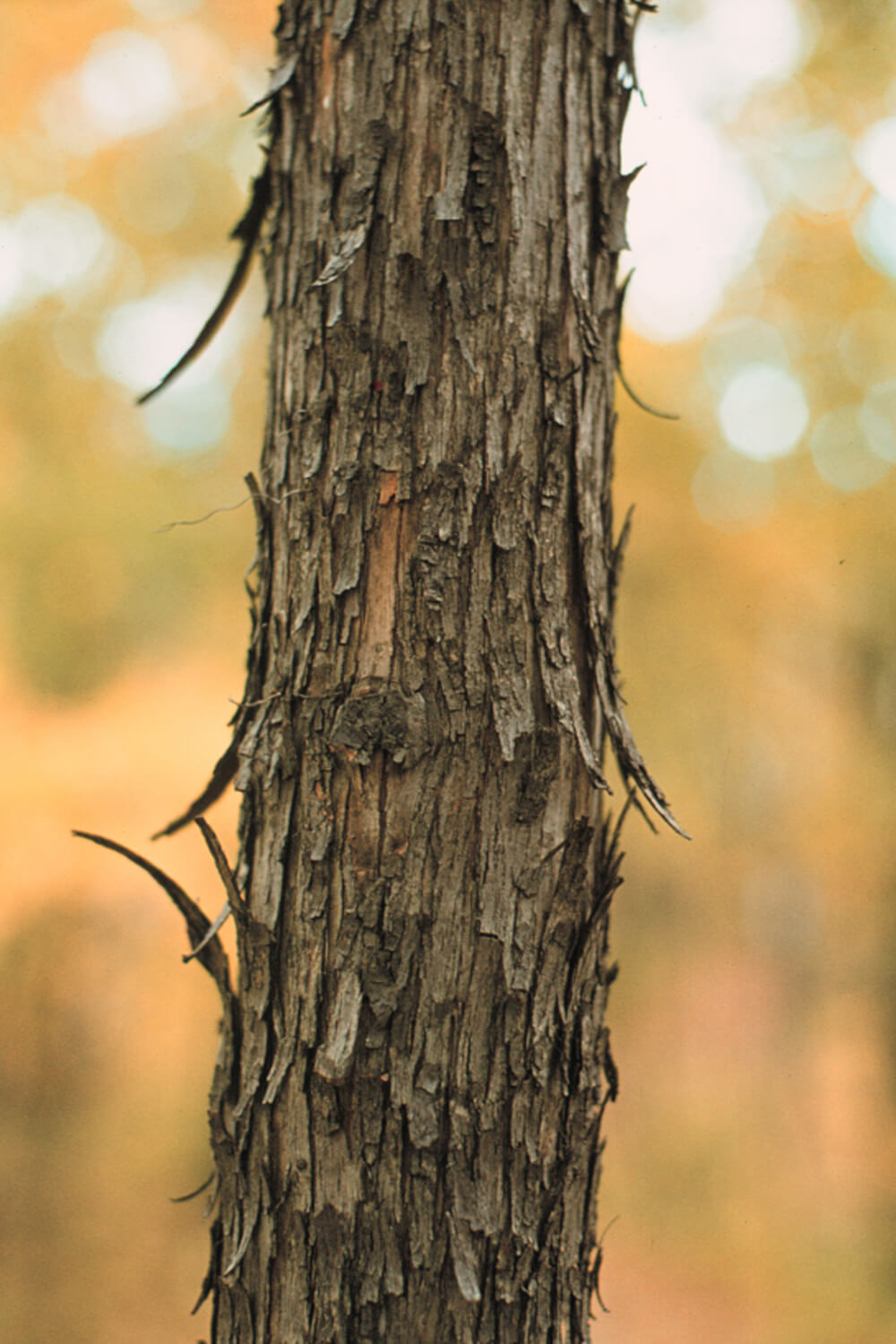May 15, 2012

The shape of the fruit gives this tree its other name, hop hornbeam.
Ironwood offers some interesting features
By Themla Kessel
Ostrya is yet another tree that may not be the eye-catcher in the landscape, but it has some very interesting features that definitely place it on the list of trees one should try in the urban landscape.
Some describe the clusters that appear at the end of the branches during autumn as looking like ostrich feet. On the same tree, this year’s fertilized female catkins produce the hop-shaped fruit that give the tree one of its other names: hop hornbeam, with its thin papery sacs that hang together in clusters of up to 20. The branches of simple, finely toothed leaves end with pendulous clusters of hops.
Once the showy yellow leaves have fallen, and the seeds have been eaten by birds and small animals, Ostrya does not fade into the anonymous shapes of winter.
If you are not yet appreciative of bark, perhaps ironwood will win you over.
While young branches are smooth brown with lenticels, the trunk develops thin shredded scales. These light textured strips twist just a little at the bottom. The fine textured shagginess is a recognizable contrast to the natural neighbours of black cherry, sugar maple, beech and its cousin the musclewood.
“Everything about this little tree is at once serviceable and self-effacing. Such members of any society are easily overlooked, but well worth knowing” (Peattie).
Ironwood is a hardy member of the deciduous understory. It grows easily in the shade of other trees, but just as easily tolerates full sun. Ostrya has a distinct trunk and pyramidal shape that changes slowly with age to a wide spreading crown with long slender branches.
Ironwood will dependably grow into a small, trouble-free tree in many types of urban conditions. There are no real pest or disease issues. Soils can be well drained to hot and droughty, and have a wide range of acidity, but deicing salt, compaction and excess moisture are challenges for Ostrya.
In the past, the very dense wood was often used for tool handles, cogs and sleigh runners. Many an inexperienced camper has tried in vain to chop a dead ironwood stem, only to reel at the jolt as if hitting an iron pipe.
For the nursery grower, production has its challenges. Growth rate is slow. Adequate germination should follow three months of warm, then three to five months cold stratification. Germination success may be highest by directly sowing slightly green seeds in August. Root pruning during production helps overcome slow growth at transplanting.
Planting an Ostrya will reward the landscape. The attractive ironwood will dependably grow into a small, trouble-free tree in many types of urban conditions. Each year it will contribute interesting fall colour, winter form and food for wildlife.
Funding was from the Farm Innovation Program, to the Landscape Ontario Growers’ Sector Group, which initiated the research project to develop a list of urban-tolerant trees that could be offered to the Ontario landscape industry. The project team, led by Thelma Kessel of Lacewing Horticulture, included Sean Fox, assistant manager, University of Guelph Arboretum, Jennifer Llewellyn, OMAFRA nursery crops specialist, and Dr. Glen Lumis, Professor Emeritus, University of Guelph.
The 29 trees on the list are considered suitable for Ontario urban settings, while encouraging species diversity. The research group feels the trees on this list have tolerance to urban situations, along with aesthetics and relative freedom from pests and diseases. The trees are similar to ash in size and form. Smaller specimens were included for sites where ash would be too large.
Ostrya is yet another tree that may not be the eye-catcher in the landscape, but it has some very interesting features that definitely place it on the list of trees one should try in the urban landscape.
Some describe the clusters that appear at the end of the branches during autumn as looking like ostrich feet. On the same tree, this year’s fertilized female catkins produce the hop-shaped fruit that give the tree one of its other names: hop hornbeam, with its thin papery sacs that hang together in clusters of up to 20. The branches of simple, finely toothed leaves end with pendulous clusters of hops.
Once the showy yellow leaves have fallen, and the seeds have been eaten by birds and small animals, Ostrya does not fade into the anonymous shapes of winter.
If you are not yet appreciative of bark, perhaps ironwood will win you over.
While young branches are smooth brown with lenticels, the trunk develops thin shredded scales. These light textured strips twist just a little at the bottom. The fine textured shagginess is a recognizable contrast to the natural neighbours of black cherry, sugar maple, beech and its cousin the musclewood.
“Everything about this little tree is at once serviceable and self-effacing. Such members of any society are easily overlooked, but well worth knowing” (Peattie).
Ironwood is a hardy member of the deciduous understory. It grows easily in the shade of other trees, but just as easily tolerates full sun. Ostrya has a distinct trunk and pyramidal shape that changes slowly with age to a wide spreading crown with long slender branches.
Ironwood will dependably grow into a small, trouble-free tree in many types of urban conditions. There are no real pest or disease issues. Soils can be well drained to hot and droughty, and have a wide range of acidity, but deicing salt, compaction and excess moisture are challenges for Ostrya.
In the past, the very dense wood was often used for tool handles, cogs and sleigh runners. Many an inexperienced camper has tried in vain to chop a dead ironwood stem, only to reel at the jolt as if hitting an iron pipe.
For the nursery grower, production has its challenges. Growth rate is slow. Adequate germination should follow three months of warm, then three to five months cold stratification. Germination success may be highest by directly sowing slightly green seeds in August. Root pruning during production helps overcome slow growth at transplanting.
Planting an Ostrya will reward the landscape. The attractive ironwood will dependably grow into a small, trouble-free tree in many types of urban conditions. Each year it will contribute interesting fall colour, winter form and food for wildlife.
Urban tolerant trees
This is the fifth in a series of articles highlighting 29 trees selected by the Landscape Ontario Growers’ Sector working group, as recommended alternatives to ash and Norway maple. For the complete list and factsheets on each, go to landscapeontario.com/trees-for-urban-landscapes.Funding was from the Farm Innovation Program, to the Landscape Ontario Growers’ Sector Group, which initiated the research project to develop a list of urban-tolerant trees that could be offered to the Ontario landscape industry. The project team, led by Thelma Kessel of Lacewing Horticulture, included Sean Fox, assistant manager, University of Guelph Arboretum, Jennifer Llewellyn, OMAFRA nursery crops specialist, and Dr. Glen Lumis, Professor Emeritus, University of Guelph.
The 29 trees on the list are considered suitable for Ontario urban settings, while encouraging species diversity. The research group feels the trees on this list have tolerance to urban situations, along with aesthetics and relative freedom from pests and diseases. The trees are similar to ash in size and form. Smaller specimens were included for sites where ash would be too large.

